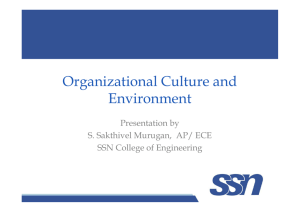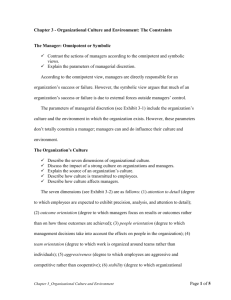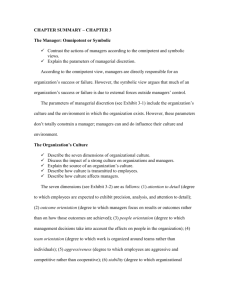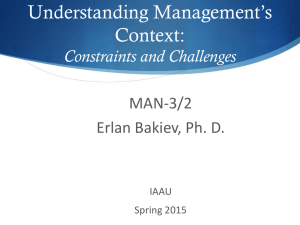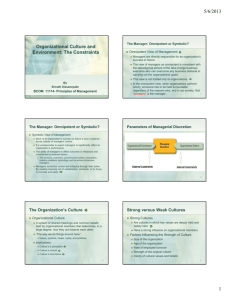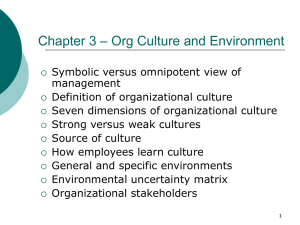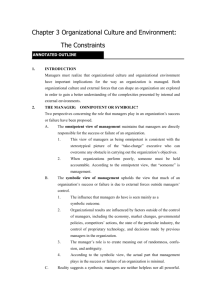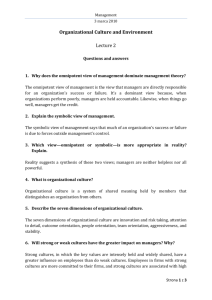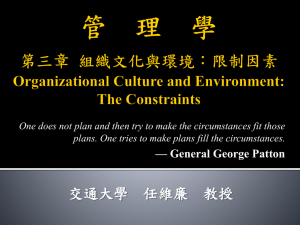Management 8e. - Robbins and Coulter
advertisement
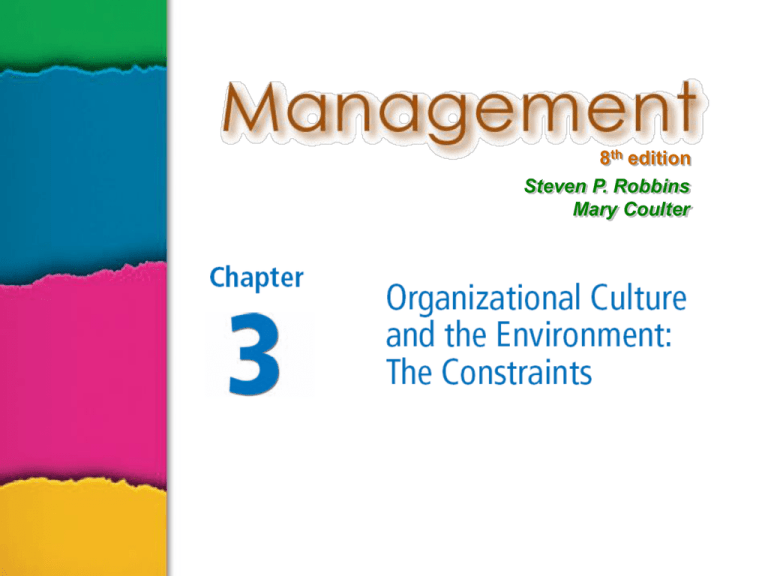
8th edition Steven P. Robbins Mary Coulter The Manager: Omnipotent or Symbolic? • Omnipotent (all-powerful) View of Management Managers are directly responsible for an organization’s success or failure. The quality of the organization is determined by the quality of its managers. Managers are held most accountable (considered responsible) for an organization’s performance yet it is difficult to attribute (to connect) good or poor performance directly to their influence on the organization. Page 49 3–2 The Manager: Omnipotent or Symbolic? • Symbolic (representative) View of Management Much of an organization’s success or failure is due to external forces outside of managers’ control. The ability of managers to affect outcomes is influenced and constrained (limited) by external factors. The economy, customers, governmental policies, competitors, industry conditions, technology, and the actions of previous managers Managers symbolize (represent) control and influence through their action. 3–3 The Manager: Omnipotent or Symbolic? • Actions of managers according to the omnipotent and symbolic views: Omnipotent view: Actions include anticipating change; exploiting opportunities; correcting poor performance; leading organizations toward their goals. Symbolic view: Actions include developing plans; making decisions; engaging in activities for the benefit of stockholders, customers, employees and the public. Managerial discretion (freedom to act independently): Managers are neither powerless nor all-powerful. Although they operate within constraints imposed by the organization’s culture (internal constraints) and the environment (external constraints), they can still influence the organization’s performance. Page 50 3–4 Parameters of Managerial Discretion Exhibit 3.1 3–5 The Organization’s Culture (character) • Organizational Culture A system of shared meanings and common beliefs held by organizational members that determines, in a large degree, how they act towards each other. “The way we do things around here.” Values, symbols, rituals (usual behavior), myths (beliefs), and practices. Implications (meanings): Culture is a perception (based on what is seen, heard or experienced) Culture is shared (described by all in similar terms) Culture is descriptive (it describes rather than evaluates) Page 51 3–6 Dimensions of Organizational Culture • Seven dimensions (principles, components) capture the essential meanings of an organization’s culture. One or more of these dimensions may be emphasized in various degrees of importance, which gives the organization its distinctive personality (character). Attention to Detail Outcome Orientation People Orientation Team Orientation Aggressiveness (being fearless and enterprising) Stability (being free from change) Status quo = maintaining the existing situation Innovation and Risk Taking Page 51 3–7 Dimensions of Organizational Culture Exhibit 3.2 3–8 Strong versus Weak Cultures • Strong Cultures Are cultures in which key values are deeply held (strongly committed to) and widely shared (accepted and applied by everyone). They Have a greater influence on employees than do weak cultures Employees are more committed than those in organizations with weak cultures Strong cultures promote high performance. • Factors Influencing the Strength of Culture Size of the organization Age of the organization Rate of employee turnover (that have to be replaced) Strength of the original culture Clarity (easy to understand) of cultural values and beliefs Page 52 3–9 Organizational Culture • Sources of Organizational Culture The organization’s founders (those who started the business) Their vision or mission and the image they project of what the organization should be. Past practices of the organization The way things have been done before The behavior of top management E.g. Their focus on aggressiveness or treating employees as family. • How the Organizational Culture Continues Recruitment of like-minded employees who “fit” Socialization of new employees to help them adapt to the culture. Page 53 3–10 How an Organization’s Culture Is Established and Maintained Exhibit 3.4 3–11 How Employees Learn Culture • Stories Telling stories of significant events or actions and people that show the spirit of the organization, presented in print or videos. • Rituals Repetitive sequences of activities that express and reinforce the values of the organization. E.g. Morning physical exercises or singing as it is done in Japan. • Material Symbols Physical assets distinguishing the organization. E.g. Type of automobiles, of furniture, the size of offices, dress code. • Language Acronyms (word forms), characteristic language, use of terms, phrases, and word meanings specific to an organization. Page 55 3–12 How Culture Affects Managers • Cultural Constraints that affect Managers Managerial actions that the organizational culture recognizes as proper or improper (right or wrong) Organizational activities that the culture values and encourages The strength or weakness of the organizational culture Simple rule for getting ahead in an organization: Find out what the organization rewards and do those things. 3–13 Managerial Decisions Affected by Culture • Planning • The degree of risk that plans should contain • Whether plans should be developed by individuals or teams • The degree of environmental scanning in which management will engage • Organizing • How much autonomy (independence) should be designed into employees’ jobs • Whether tasks should be done by individuals or in teams • The extent of interaction (acting together) between department managers Exhibit 3.5a Page 58 3–14 Managerial Decisions Affected by Culture • Leading • The degree to which managers are concerned with increasing employee job satisfaction • What styles of leadership are appropriate • Whether all disagreements—even constructive ones—should be eliminated • Controlling • Whether to impose external controls or to allow employees to control their own actions • What criteria (basis for comparison) should be used when evaluating employee performance • What consequences will occur from exceeding one’s budget Exhibit 3.5b 3–15 Suggestions for Managers: Creating a More Ethical Culture • Be a visible role model. • Communicate ethical expectations (tell what is right and wrong). • Provide ethics training. • Visibly reward ethical (honorable) acts and punish unethical ones. • Provide protective mechanisms so employees can discuss ethical dilemmas (problems) and report unethical behavior without fear. Exhibit 3.6 Page 59 3–16 Organization Culture Issues • Creating an Ethical Culture High in risk tolerance Low to moderate aggressiveness Focus on means as well as outcomes • Creating an Innovative Culture Challenge and involvement Freedom Trust and openness Idea time Playfulness/humor Conflict resolution Debates Risk-taking 3–17 Organization Culture Issues (cont’d) • Creating a Customer-Responsive Culture Hiring the right type of employees (ones with a strong interest in serving customers) Having few rigid rules, procedures, and regulations Using widespread (general) empowerment of employees Having good listening skills in relating to customers’ messages Providing role clarity to employees to reduce ambiguity (lack of clarity) and conflict and increase job satisfaction (clearly define responsibilities so as to eliminate confusion) Having conscientious, caring employees willing to take initiative Page 60 3–18 Spirituality and Organizational Culture •Workplace Spirituality The recognition that people have an inner life (deep feelings and emotional states) that nourishes (provides) and is nourished by meaningful work that takes place in the context of community. Employees are looking for ways to cope with stress and pressures in their lives. •Characteristics of a Spiritual Organization Strong sense of purpose (important role) Focus on individual development Trust and openness Employee empowerment (authorizing decision making) Toleration (acceptance) of employees’ expression (allowing people to express feelings and be themselves) Page 61 3–19 Benefits of Spirituality • Improved employee productivity • Reduction of employee turnover • Stronger organizational performance • Increased creativity • Increased employee satisfaction • Increased team performance • Increased organizational performance 3–20 Defining the External Environment • External Environment The forces and institutions outside the organization that potentially can affect the organization’s performance. • Components of the External Environment Specific environment: external forces that have a direct and immediate impact on the organization (e.g. customers, suppliers, competitors). General environment: broad economic, sociocultural (e.g. religion, lifestyles, technology), political/legal, demographic (e.g. gender, age, education, income), technological, and global conditions that may affect the organization. Page 63 3–21 The External Environment Exhibit 3.8 3–22 How the Environment Affects Managers • Environmental Uncertainty The extent to which managers have knowledge of and are able to predict change in their organization’s external environment is affected by: Dimensions in Environmental Uncertainty Complexity of the environment: the number of components in an organization’s external environment. Degree of change in environmental components: how dynamic or stable the external environment is. Page 68 3–23 Environmental Uncertainty Matrix Exhibit 3.10 3–24 Stakeholder Relationships • Stakeholders Any constituencies in the organization’s external environment that are affected by the organization’s decisions and actions • Why Manage Stakeholder Relationships? It can lead to improved organizational performance. It’s the “right” thing to do given the interdependence of the organization and its external stakeholders. Page 70 3–25 Organizational Stakeholders Exhibit 3.11 3–26 Managing Stakeholder Relationships 1. Identify the organization’s external stakeholders (which groups might be affected by decisions?). 2. Determine the particular interests and concerns of the external stakeholders (e.g. product quality, financial issues). 3. Decide how critical each external stakeholder is to the organization (some are more critical than others). 4. Determine how to manage each individual external stakeholder relationship (depending on how critical the stakeholder and how uncertain the environment are). Page 71 3–27 C H A P T E R R E V I E W 1/3 The Manager: Omnipotent or Symbolic (slide 4) • Contrast the actions of managers according to the omnipotent and symbolic views. • Explain the parameters of managerial discretion. The Organization’s Culture (slides 8, 9, 10, 12) • Describe the seven dimensions of organizational culture. • Discuss the impact of a strong culture on organizations and managers. • Explain the source of an organization’s culture and how that culture continues. • Describe how culture is transmitted to employees. 3–28 C H A P T E R R E V I E W 2/3 Current Organizational Issues Facing Managers (slides 17, 18, 19) • Describe the characteristics of an ethical culture, an innovative culture, and a customer-responsive culture. • Discuss why workplace spirituality seems to be an important concern. • Describe the characteristics of a spiritual organization. 3–29 C H A P T E R R E V I E W 3/3 •The Environment (slides 21, 23, 26, 27) • Describe the components of the specific and general environments. • Discuss the two dimensions of environmental uncertainty. • Identify the most common organizational stakeholders. • Explain the four steps in managing external stakeholder relationships. 3–30

